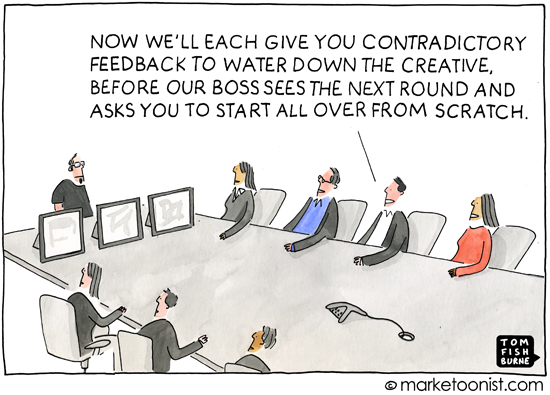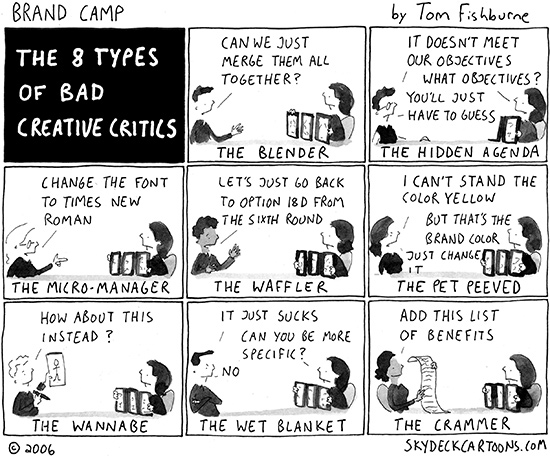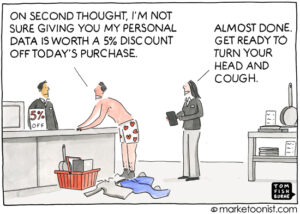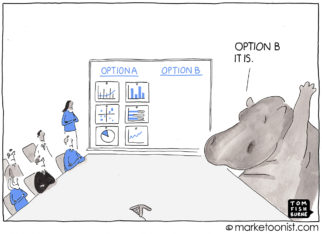How we review creative is as valuable a part of the creative process as the creative itself. Yet the creative review is often overlooked and frequently misunderstood. The most talented designers in the world will create mediocre work if the creative review process is managed in a mediocre way.
I love the video that circulated a few years ago called “Microsoft Designs the iPod Package”. In several hysterically accurate minutes, the sleek Apple packaging design devolves into a cluttered mess because of creative feedback from the Microsoft marketing team. The fascinating epilogue is that it turns out the video was created by Microsoft designers to make a point to their own marketing colleagues.
As a Microsoft spokesperson said at the time, “It was an internal-only video clip commissioned by our packaging team to humorously highlight the challenges we have faced RE: packaging and to educate marketers here about the pitfalls of packaging and branding.”
Breakthrough creative only starts when we treat our creative partners as partners.
I’d love to hear your tips and recommendations on reviewing creative. Following is a cartoon I drew in 2006 on some of the pitfalls of critiquing creative.
(Marketoonist Monday: I’m giving away a signed cartoon print. Just share an insightful comment to this week’s post by 5:00 PST on Monday. Thanks!)




Janine Heffelfinger says
This makes me want to name names…
Mike says
We concept a lot of digital DR in my part of the shop. And that’s where clients (mostly former media peeps) get very …um… SPECIFIC with their comments. Lots of brief rewriting as we go through the rounds of stakeholders too. (Sound familiar anyone?) We have learned through the years when showing each concept in a deck to deliver lots (but not too many) design versions, using Lorem Ipsum. And then, deliver a copy deck with probably 8 or 9 different copy variations. It seems like a lot of upfront work, but over the long haul it’s less painful. And oddly, it works.
Because when the menu is thick like a Greek diner, there’s always something to eat.
Tom Denford ID Comms says
Works perfectly for media too! Love this one Tom. Its too common a situation sadly. But if the agency made sure they before they started work they were working to a very clear brief then at least they could, at this point, refer everyone back to the brief and negate the “8 Types” because the original brief would expose the unhelpful critics. Agencies play a part in these situations, its not just naughty clients. Agencies must force their clients to brief them well, if necessary help the client to write the brief, get everyone signed off to it and THEN start working. Have a copy of the brief to hand in the review to defend the work (if it is indeed the right work for the brief).
Diana Soller says
Agreed, Tom Fishburne and Tom Denford. Another pitfall happens when client or agency stakeholders transition. Especially for longer running projects, these transitions can really throw a project off track. What I have learned is that when these transitions happen it is important to go back to the original brief and make sure that everyone is still in alignment.
Beth Barbee says
I couldn’t agree more with Tom Denford’s comments. Typically, it is an account person’s role to populate the brief, which functions as a dumping ground for every factoid the client has ever mentioned. As a brand strategist myself, I work to get unity from the stakeholders about what the brand stands for, what its personality is, etc. etc. to avoid unraveling and strategic re-works mid creative process. Unfortunately, far too many firms (and clients) use the creative to work through the questions that were never asked in the beginning. At the root of it all, it seems to come down to two major issues: time, and ownership. The client never seems to have enough time up front to be thorough (especially among themselves), and everyone wants the solution tomorrow. No one is willing to own their share of responsibility, yet everyone wants to own the great idea.
Really liked this marketoon!
Morten Riisgaard-Dam says
This one nails it! A classic. Knows ’em all :o)
But I would have to agree with Tom D – it all starts with an investment in a super brief! And to make sure everyone has a common starting point I recommend the investment in a de-brief where creatives gets the chance to make an “preliminary interpretation” of the brief. In my book – time well spend!
Dan N says
perhaps the most insidious challenge, and the theme through all of these 8 (and the other uncountable ‘types’ of critics*), is that the responses are all based on the perspective of the reviewer and their personal or professional role — not asingle one is based on the perspective and the anticipated reaction of the customer.
(* even the use fo the word ‘critic’ is problem … if the reviewer truly felt that they and the creator are partners they and all would consider them ‘aupporters’ or ‘partners’ or ‘advisors’.)
Kathleen Leigh says
We’re all guilty. Reminds me of this video “Redesigning the Stop Sign” http://www.youtube.com/watch?v=Wac3aGn5twc Such a classic, but a reminder that process is only good when it leads to good end results!
Helen C says
Uh oh – as a client I’ve probably been guilty of several, and certainly seen many more. A well constructed brief is central (though much easier said than done and needs both client and agency time), and a good rule is that table-stakes is delivering against brief, and if an off-brief flash of inspiration has occurred then it should be presented in addition to, not instead of, the work that matches the brief.
Faris says
This is not just a problem in creative reviews, but in consulting projects in general where the client can be any one of the 8 types depicted in the second cartoon.
Having working in consulting for the last few years, I have come to the same conclusion as Tom – that a (creative) project can only be as good as the client’s review process, irrespective of the consultant / creative working on the assignment.
Judy Bernstein says
The creative tool POINt can be useful in this context. POINt solicits, in order, P: plusses (what is good right now about the idea) O: opportunities (what might this idea mean, bring about, cause to happen) I: issues (concerns) Nt: new thinking (starting with 1 issue at a time, what new thinking can be brought to that issue to help overcome it?) One of the advantages of approaching feedback in this structured way is that the team doesn’t lose sight of the elements that are strong. The ‘plusses’ are detailed as separate from the issues and so can be considered and balanced a bit more independently of each other. Baby doesn’t necessarily have to get thrown out with the bathwater as tweaks and adjustments get made.
Julie says
This is perpetuated throughout organizations of all ilk by leaders that can’t – or won’t – delegate communications to the people who know what they’re doing.
Yilmaz says
Tom Denford and Beth Barbee nailed it for me. The core of the issue is poor brief that usually leads to mediocre creative that’s not worth the paper it’s put on. Also I’d argue its agency’s priimary responsibility to ensure there’s a strong aligned brief, that’s clear on the challenge and has a true insight that’ll guide the creative team.
Anette says
Tom – I came across that cartoon years ago and have had it posted on my cubicle wall ever since. It often has allowed me to keep my cool in crazy meetings.
I’ve found, over the years, that re-presenting the brief before the creative presentation and providing the clients guidance on what they should review (i.e. colours are set by brand standards so you are just looking at the size and placement of the text and image boxes – etc.) has helped me in creative meetings. I’ve also never been afraid to say – right in the meeting – something like, “Okay, no problem, we can change that, but it means we are re-visiting the brief and will likely incur additional time to the project – are you okay with this, Ms. Client?”
I’ve never really had a problem when I’ve been able to do that.
Gregor says
Oh how precise Tom- and probably slightly painful for some to read… Sadly sometimes, like some Managers become Managers simply because they have been with an organisation for a given time, rather than because they are good at ‘managing’- some organisations do pull in a committee to judge creativity- who are not trained or informed to judge. Or a structure of voting/points system is put in place, but often this doesn’t reach the conclusion they want, so plan B is scrambled- who do we collectively like or who will be a safe bet?!….
Both are really understandable approaches. Organisations need to work with external creatives on their brief and dove-tail this with their marketing or business vision. And generally the financial parameters don’t phase the creative- but quite the opposite!
Trust, faith and confidence… oh and collaboration- all pulling together for a dynamic result.
Héctor Muñoz says
It’s always the weakest part of the project and the ultimate reason why great clients get great work.
Having worked very hard to “educate clients” in a copule of projects just let me very tired.
Adey J says
you work for a half assed agency if you can’t challenge & clarify feedback.